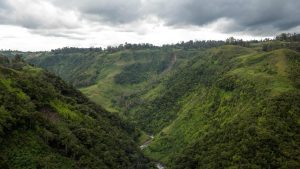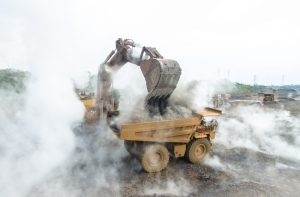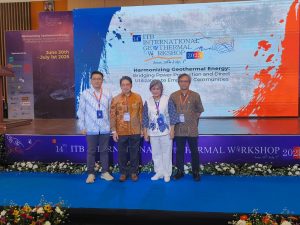
by Greg Clough
“In nature, nothing exists alone.” Rachel Carson, Silent Spring.
Growing up in suburban Australia, I remember sneaking mum’s mason jars to catch tadpoles in a nearby pond, forlornly hoping they’d grow into frogs. Now, living in suburban Indonesia, a ribbiting harmony serenades me nightly. It’s a pleasant reminder that biodiversity can thrive in town and country. The question is, for how long?
Rachel Carson’s 1962 environmental masterpiece, Silent Spring, helped spark today’s environmental movement. Her words, “in nature, nothing stands alone”, continue to remind us of the delicate harmony between people and the planet. When nothing lives alone, even the tiniest action imparts a ripple effect on our biodiversity and ecosystems. When it is a human action, the ripple often cascades into a life-extinguishing tsunami.
Sadly, this is happening with hundreds of the world’s frog species. If their loss continues at current rates, not only will we lose the joyful symphony of frogs ribbiting, but far more disturbingly, we will lose their crucial role in maintaining biodiversity and balancing ecosystems.
A recent article from Mongabay environmental news makes for sad reading. It reports how habitat loss in India’s Western Ghats pushes frogs to extinction.
It’s tragic to hear that India’s infrastructure-driven deforestation threatens frogs with extinction. This tragedy is not unique to the Western Ghats. A search of the International Union for Conservation of Nature’s database reveals 1,558 or one-fifth of the world’s estimated 7,642 frog and toad species are critically endangered.
Frogs face interconnected threats, including habitat loss and fragmentation, invasive species, pollution, climate change, and diseases. Habitat loss hinders frogs from finding mates to reproduce. Invasive species compete with native frogs for food and can transmit diseases. Climate change forces frogs to find cooler but often inhospitable altitudes.
If frogs weren’t frogs, they’d be chameleons
Frogs are versatile creatures. They’re amphibious, for a start. And they come in all shapes and colours. They’re also master multitaskers, critical to the food chain, acting as predators, prey and pollinators. Plus, much more. Even cane toads provide these services in their native environment.
As predators, frogs consume insects and other invertebrates, helping control their populations. If frogs disappear, it can cause an increase in these insects and invertebrates, creating imbalances and potential pest outbreaks. In extreme examples, the increase in insects could present a health hazard, such as raising the risk of diseases from mosquitoes carrying malaria, yellow or dengue fever.
As prey, frogs are a food source for snakes, birds and mammals. The extinction of frogs can harm the survival of these predators. Frog loss could also trigger a cascading effect across the ecosystem as predators shift to other prey, causing further impacts down the food chain.
As pollinators, frogs often feed on the nectar of flowers, transferring pollen from one flower to another and contributing to plant species’ reproduction and genetic diversity. If frogs become extinct, plants that rely on frog pollinators may face challenges reproducing and maintaining viable populations.
As seed dispersers, frogs often eat fruits and excrete the seeds in different locations, helping to colonize new areas and promoting genetic diversity. If frogs vanish, seed dispersal may decline significantly, and plants may be unable to expand their range and adapt to changing environmental conditions.
As nutrient cyclers, frogs excrete organic fertilizer in their waste matter, benefiting plant growth and overall ecosystem productivity. If frogs die out, the loss of nutrients could affect plant health, growth and diversity.
As wetland inhabitants, frogs often interact with specific plant communities. Their feeding on vegetation, their tadpoles grazing on algae, and their movement through wetlands can shape the structure and composition of vegetation. The loss of frogs could favour certain plants over others, changing the composition of wetland plant species.
As climate change indicators, frogs are sensitive to environmental changes, and by declining or dying out, they can indicate broader ecological imbalances and ecosystem degradation resulting from climate change or other causes.
How to keep frogs “ribbiting”
The extinction of frogs seriously threatens the health of many ecosystems. Taking steps to protect frogs and their habitats is critical. Here are some approaches:
• Preserving and restoring the wetlands, forests and ecosystems that provide frogs essential breeding grounds and shelter.
• Reducing or eliminating pesticides and herbicides that harm frogs and their habitats.
• Controlling the invasive species that prey on frogs or compete with them for resources.
• Conducting scientific research to understand frogs and their habitats better.
• Monitoring population trends and implementing effective conservation measures.
• Preventing the spread of diseases that devastate frogs.
And in the end …
As Rachel Carson wrote, “In nature, nothing exists alone”. Allowing the unchecked loss of frogs risks disrupting the intricate balance of ecosystems and jeopardising the well-being of countless other organisms. We can protect frogs by conserving their habitats, curbing harmful chemicals, managing invasive species and encouraging community conservation.
It is time we embraced this responsibility and ensured the enchanting ribbit symphony of frogs continues to echo – in town and country – harmonising our planet and inspiring future generations.
It’s also time young boys learned not to poach tadpoles!
Banner photo: Maxim Michurin1109/shutterstock.com













